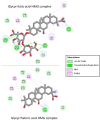Glycyrrhizin: An alternative drug for the treatment of COVID-19 infection and the associated respiratory syndrome?
- PMID: 32592716
- PMCID: PMC7311916
- DOI: 10.1016/j.pharmthera.2020.107618
Glycyrrhizin: An alternative drug for the treatment of COVID-19 infection and the associated respiratory syndrome?
Abstract
Safe and efficient drugs to combat the current COVID-19 pandemic are urgently needed. In this context, we have analyzed the anti-coronavirus potential of the natural product glycyrrhizic acid (GLR), a drug used to treat liver diseases (including viral hepatitis) and specific cutaneous inflammation (such as atopic dermatitis) in some countries. The properties of GLR and its primary active metabolite glycyrrhetinic acid are presented and discussed. GLR has shown activities against different viruses, including SARS-associated Human and animal coronaviruses. GLR is a non-hemolytic saponin and a potent immuno-active anti-inflammatory agent which displays both cytoplasmic and membrane effects. At the membrane level, GLR induces cholesterol-dependent disorganization of lipid rafts which are important for the entry of coronavirus into cells. At the intracellular and circulating levels, GLR can trap the high mobility group box 1 protein and thus blocks the alarmin functions of HMGB1. We used molecular docking to characterize further and discuss both the cholesterol- and HMG box-binding functions of GLR. The membrane and cytoplasmic effects of GLR, coupled with its long-established medical use as a relatively safe drug, make GLR a good candidate to be tested against the SARS-CoV-2 coronavirus, alone and in combination with other drugs. The rational supporting combinations with (hydroxy)chloroquine and tenofovir (two drugs active against SARS-CoV-2) is also discussed. Based on this analysis, we conclude that GLR should be further considered and rapidly evaluated for the treatment of patients with COVID-19.
Keywords: COVID-19; Cholesterol; Coronavirus; Glycyrrhizin; HMGB1; Natural product.
Copyright © 2020 Elsevier Inc. All rights reserved.
Conflict of interest statement
Declaration of Competing Interest The authors declare no conflict of interest associated with this publication and there has been no significant financial support for this work that could have influenced its outcome.
Figures










References
-
- Avgustinovich D., Tsyganov M., Vishnivetskaya G., Kovner A., Sorokina I., Orlovskaya I.…Mordvinov V. Effects of supramolecular complexation of praziquantel with disodium glycyrrhizinate on the liver fluke Opisthorchis felineus: An in vitro and in vivo study. Acta Tropica. 2019;194:1–12. - PubMed
Publication types
MeSH terms
Substances
LinkOut - more resources
Full Text Sources
Other Literature Sources
Miscellaneous

